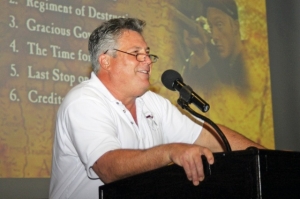Lecture shares view on Civil War general
By Dennis Hill
Published in News on March 11, 2015 1:46 PM

News-Argus/DENNIS HILL
Historian Kirk Keller addresses the audience before a screening of a documentary film on the Civil War march of Gen. William T. Sherman. Sherman's objective was Goldsboro. A re-enactment of the Battle of Bentonville, fought 20 miles west of the city, will be held March 21-22 at the battlefield site.
One hundred and fifty years ago this week, residents of Goldsboro were scared.
The Civil War had raged for more than four years, the army of Union Gen. William T. Sherman had entered North Carolina after laying waste to much of Georgia and South Carolina, and people in the state feared the worst.
Sherman's march was the subject of a film and lecture presented Tuesday night at Wayne Community College. The event held special meaning for Wayne County residents since Sherman's objective was Goldsboro, where he hoped to meet up with Union forces moving inland from the coast.
On Tuesday night, local historian Kirk Keller spoke before and after the documentary, offering up the opinion that Sherman was not the monster many people in the South have always considered him.
"Try to look at it from the outside in," Keller urged the audience, saying Sherman's hard-nosed style of warfare helped bring about a quicker end to the war and saved lives in the long run.
The showing of the film was just one of several events being held on the eve of the re-enactment of the Battle of Bentonville on March 21-22, when nearly 4,000 Civil War re-enactors will demonstrate how Southern forces tried to stop Sherman's advance in the last major battle of the war.
Dean Harry, president of the Friends of Bentonville Battlefield, will speak Tuesday, March 17, at WCC on the battle itself. And on Friday, March 20, a concert featuring Civil War-era music will be held at the college.
On Tuesday, Sherman was shown to be a master of strategy. He saw the destruction his men were inflicting as necessary to shorten the war.
Sherman's army consisted of 60,000 men in two wings. They formed a 60-mile wide front and had burned and pillaged their way through Georgia and South Carolina.
But after putting the whip to those two states, Sherman told his men to ease up on North Carolina, which had been the last state to join the Confederacy.
That didn't stop them from burning the arsenal at Fayetteville as they marched north. After leaving Fayetteville, Sherman feinted towards Raleigh to keep Southern military commanders in doubt, then turned east toward his real objective -- the railroad crossing at Goldsboro.
Confederate forces under the command of Gen. Joseph E. Johnston tried to prevent him from reaching the city by striking at Bentonville, about 20 miles west. But Johnston's army was too small and after a three-day battle, he withdrew to Smithfield and Sherman occupied Goldsboro.
Here he linked up with Union forces moving up from Wilmington and New Bern, doubling the size of his army.
The war ended a month later.
The re-enactment of the battle is expected to draw as many as 50,000 spectators from across the country. Tickets for the two battle re-creations, one on Saturday and one on Sunday, can be purchased online at www.150thbentonville.com, at the battlefield itself, or by calling 910-594-0789. Advance tickets are $12 for adults and $6 for children 12 and under. At the gate, tickets will be $15 and $10.
